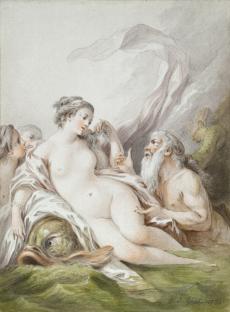


It is evidence of Jean-Baptiste Huet’s versatility – but also of his continuing fidelity to his original inspirer, François Boucher (1703-1770) – that, in the same year as he produced the rural subject of a 'Landscape with a Lady Angling', he could come up with these two ‘history pictures’. Yet, they also show how much, in this respect, he differed from his master. Where Boucher would have studied the poses of his female nudes from the life, and would have given the compositions a powerful erotic charge, Huet depicted formulaic bodies and suggested little more than the embarrassment of young women caught in a state of undress. His technique, however, is deft, and he manifested a fine sense of subtle colours to accompany that of pale pink flesh.
It is piquant that Huet should have painted this pair of pictures, doubtless for some private collector, in 1783, the year in which he sent no exhibits to the Salon. For it was there, four years before, that he had suffered the worst critical reception of his career, for his sole exhibit in 1779, a huge picture of Hercules and Omphale (location unknown). Most critics accused him of an inability to depict the nude. One of the more scurrilous, the author of Ah! Ah! Encore une critique, wrote: ‘Why did he seek to venture outside his own domain? Some unkind wits claimed that he would have done better to paint Hercules as a bull, Omphale as a heifer, and Cupid as a gosling.’ In watercolour, however, and on the present scale, the artist evaded such criticism, since it is clear that his ambitions were largely decorative.
The title of the first of this pair of watercolours goes back to the engraving of it by Louis-Marin Bonnet (1736-1793), whose full title was Thétis Écoute Protée qui lui Prédit qu’elle Auroit un Fils plus Puissant que son Pére [Thetis listens to Proteus, who predicts that she will have a son more powerful than his father]. The subject was one new to art: no representation of it was shown in any of the 18th-century French Salons, nor did Pigler record any instance of it in his Barockthemen. Thetis and Proteus were sea deities, each with the power of metamorphosis; Proteus additionally had the gift of prophecy. According to Ovid’s Metamorphoses, Book XI, Proteus counselled Thetis to bear a child and told her that, if she did so, the boy would grow into a greater hero than his father. This deterred even Jupiter from seducing her, though he was tempted to, and he arranged instead for her to couple with a mortal, Peleus. The son born of this union was Achilles, and it was at the wedding banquet of Peleus and Thetis that the uninvited Eris threw down the golden apple for ‘the fairest of them all’, which led, through Paris’ choice of Venus, to the Trojan War.
Jupiter and Semele was less unusual as a subject. Semele, having been made love to by Jupiter in the guise of an ordinary mortal, and already six months pregnant by him, was cynically advised by the jealous Juno to persuade him to come to her in his full glory as a god. She was consumed by the divine fire, but Mercury rescued her unborn child by sewing him into Jupiter’s thigh, from which he was born as Bacchus. Boucher’s pupil and son-in-law, Jean-Baptiste Deshays (1729-1765), appears to have depicted it in the much more dramatic sketch on the recto of a sheet now in the National Gallery of Art in Washington, DC; and an artist similar to Huet, Jacques-Philippe Caresme (1734-1796), had done so in a painting that was auctioned in 1774 (location unknown).
When these two watercolours were engraved by Bonnet, the pendant of Jupiter and Semele was after another watercolour of Huet’s, specifically stated also to have been done in 1783, Jupiter and Io, whilst Thetis and Proteus was paired with the equally exceptional subject of Hesperia, Pursued by Aesacus, Bitten by a Snake. The two watercolours shown here – and almost certainly the originals of their engraved pendants – were amongst six scenes taken from the Metamorphoses that formed lot 29 in Bonnet’s posthumous sale, 7 brumaire l’an 2 (7 November 1793).
From a large family of artists, he practised in Paris as a painter, engraver and designer. Strongly influenced by François Boucher, he produced pastoral landscapes and genre scenes in the Rococo style; he had a gift for depicting animals. Aside from his engravings, he is also known for his decorative art designs, in particular for textiles.